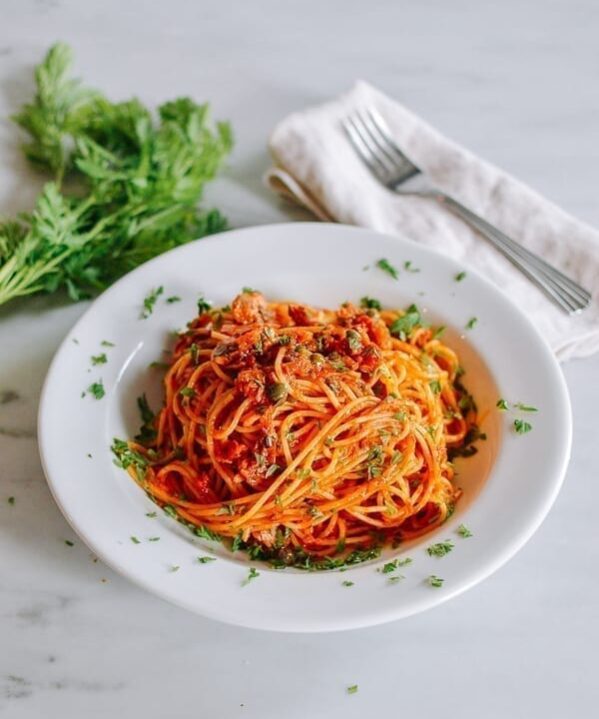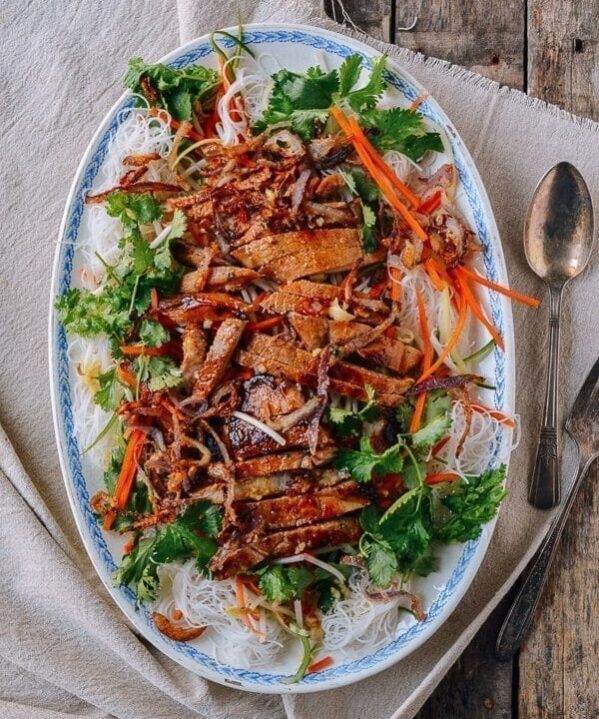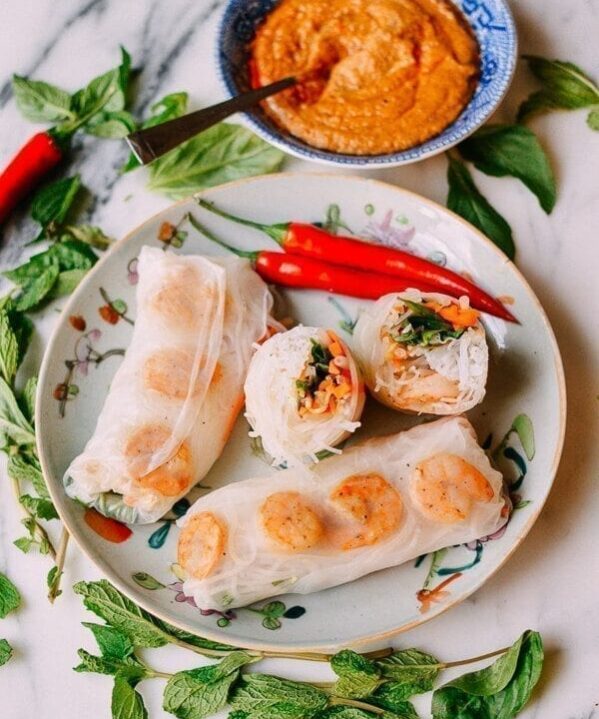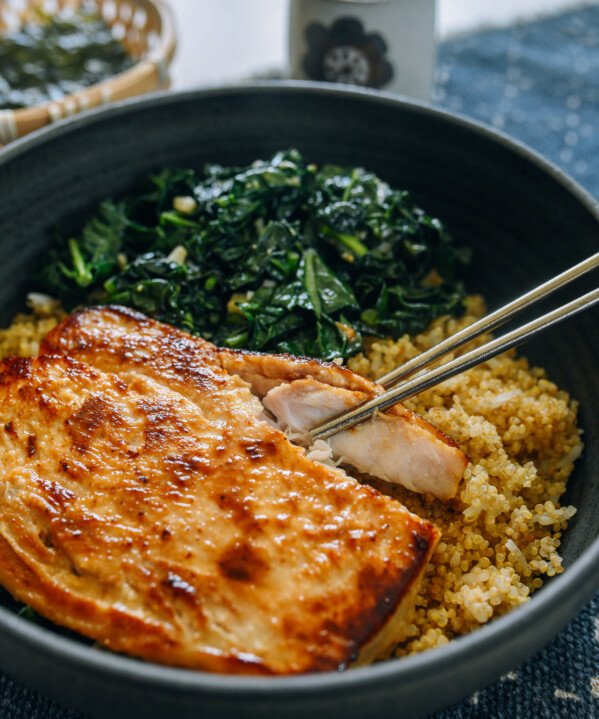Seared Ahi Tuna with fresh lime, mandarin orange juice, ginger, garlic, soy, and sesame is perfect for summer meals. This impressive restaurant-style dish is easy—and fast—to pull off at home!
Perfect, Restaurant-style Seared Ahi Tuna
You’ve probably had seared ahi tuna at your favorite restaurant, but recently we discovered it’s easier than you think to make—and very quick!
The outside is cooked and the inside is still raw, preserving the tuna steaks’ flavor and texture. Ahi is best when served on the rare side (fully cooked, it can be dry).
We created a dressing that’s bursting with fresh flavors that really complement the fish. We also use a mix of black and white sesame seeds, which makes for a fragrant coating and crunch, as well as a striking look.
Salting the tuna before searing it is a key seasoning step that you shouldn’t skip. The sauce drizzled over the top of the seared tuna gives it that final explosion of flavor, but the salt underneath ensures that the flavors of the sauce really pop. A small squeeze of lime provides a nice fresh acidic contrast, while sliced avocado gives the dish richness.

Why Tuna Is Better Rare
Ahí tuna is best enjoyed rare with a slightly cool, tender center.
- Rare tuna is tender like sushi.
- Rare tuna absorbs the flavorful sauce much better than fully cooked tuna.
- The contrast of the rare center and the seared sesame crust is delicious!
- Well done tuna is similar to well done beef steak and can be tough and dry. It’s also much harder to slice (it will break apart!)
Restaurants serving raw fish must provide a written consumer advisory, stating that consuming raw or undercooked meats, poultry, seafood, shellfish, or eggs may increase the risk of foodborne illness. Keep the same in mind when you are making and eating rare or raw tuna at home!
Different Types of Tuna
Ahi tuna is yellowfin tuna, and it is the most common type you see in sushi restaurants and poke spots. That’s what we’re using in this recipe, as it is most widely accessible. Let’s talk about the most common types of tuna we eat.
Yellowfin tuna: Yellowfin tuna thrive in warmer, more shallow tropical and subtropical waters. The fish max out at around 450 pounds, and the meat is very lean. Generally, this is what you’re buying if you’re at the grocery store or local fishmonger looking for tuna steaks.
Bigeye tuna: These fish are similar to yellowfin. They have darker flesh and slightly more fat than yellowfin, and tend to be larger. You can also use bigeye tuna in this recipe! Both yellowfin and bigeye may be referred to as “ahi,” a Hawaiian word used interchangeably for both species of fish.
Bluefin tuna: These fish prefer cooler, more temperate conditions in both the Atlantic and Pacific oceans. Bluefin tuna has a richer, fattier taste, and are more significantly expensive and rare. (Cold water = more fat stores!) Bluefins can exceed 1000 pounds! Prized bluefin tuna apparently have no limits when it comes to price. Earlier this year, a bluefin tuna roughly the size (and weight!) of a motorcycle sold for $1.3 million at a Tokyo fish market. It’s no wonder, given a small sashimi slice can set you back anywhere from $7-$16 depending on the cut.
Then there is albacore tuna (firm white fish found in “solid white” tuna cans) and skipjack tuna (smaller fish with a stronger flavor, used in chunk light canned tuna).
Where to Buy Ahi Tuna
Luckily, you don’t have to spend a fortune in Tokyo to get your hands on ahi tuna. You can find it in quality grocery stores frozen or at your local fishmonger. It’s always sold in fillets or steaks and is usually flash frozen before reaching retail fish counters.
Look for ahi tuna that’s designated as “sushi grade.” While “sushi grade” isn’t an official or regulated term, it does indicate that the retailer is saying that the piece of fish is safe to consume raw.
Recently I had the privilege of traveling to Panama with some friends and family to experience offshore fishing for yellowfin tuna. We caught our fair share of fish! Some of them were almost as tall as us! We brought filets in a cooler back home on the plane, so our family was lucky enough to enjoy my own fresh-caught ahi tuna in our home kitchen!
Inspired by the trip and the ways the boat and hotel cooks prepared our catch, I devised this recipe with plenty of fresh flavors from mandarin oranges, lime, rice vinegar, garlic, ginger, soy sauce, and avocado!
If you haven’t tried making seared ahi tuna at home yet, you must try our recipe!

Seared Ahi Tuna Recipe Instructions
Keep the tuna cold in the refrigerator right up until you are ready to cook.
Squeeze the fresh mandarin orange juice and pulp into a bowl, or peel and chop, using the side of a broad knife to scoop up the fruit and juices into a bowl. Add the garlic, ginger, white portion of the scallion, soy sauce, honey, rice vinegar, and sesame oil. Mix well and set aside with the green parts of the chopped scallion.


On your serving plate(s), fan out the sliced avocado and squeeze a little lime juice over the top so they don’t turn brown. Place another lime wedge on the side of the plate for serving. You can do this on one family-style plate or individual plates like we did.
Lightly rub both sides of the tuna filets with oil and salt. Coat each side with sesame seeds. Optionally, you can also coat the sides of the filets so they’re totally covered.


Heat a cast iron or carbon steel skillet until lightly smoking, and coat the pan in oil. It should be VERY HOT. Gently lay the tuna steaks in the pan, without disturbing them. Sear for 30 to 60 seconds each side (shorter for rare tuna, longer for medium rare).


Transfer the fish to a cutting board, and let it rest for 2 minutes before slicing. Use a very sharp knife to slice the tuna at a slight angle into ½-inch slices. Place the sliced tuna over the sliced avocado.
Spoon the sauce over the tuna, and top with the chopped scallion greens and a pinch of flaky salt if using. Serve immediately, and squeeze additional lime juice over the top if desired!


Seared Ahi Tuna

Ingredients
- 12 ounces ahi tuna steaks (yellowfin or bigeye, 1½-inches/4cm thick)
- 1 fresh mandarin orange or clementine
- 1 teaspoon grated or minced garlic
- 1 teaspoon grated or minced ginger
- 1 scallion (finely chopped with the white and green parts separated)
- 1½ tablespoons soy sauce
- 1 tablespoon honey
- 1 teaspoon rice vinegar
- 1 teaspoon sesame oil
- 1 large avocado (thinly sliced)
- 1 lime (cut into wedges)
- ¼ teaspoon sea salt (for salting the tuna)
- 2 tablespoons black sesame seeds
- 2 tablespoons white sesame seeds
- 2 tablespoons neutral oil (such as canola, vegetable, or avocado oil)
- Flaky sea salt (optional)
Instructions
- Keep the tuna cold in the refrigerator right up until you are ready to cook.
- Squeeze the fresh mandarin orange juice and pulp into a bowl, or peel and chop, using the side of a broad knife to scoop up the fruit and juices into a bowl. Add the garlic, ginger, white portion of the scallion, soy sauce, honey, rice vinegar, and sesame oil. Mix well and set aside with the green parts of the chopped scallion.
- On your serving plate(s), fan out the sliced avocado and squeeze a little lime juice over the top so they don’t turn brown. Place another lime wedge on the side of the plate for serving. You can do this on one family-style plate or individual plates like we did.
- Lightly rub the salt on both sides of the tuna filets. Coat each side with sesame seeds. Optionally, you can also coat the sides of the filets so they’re totally covered.
- Heat a cast iron or carbon steel skillet until lightly smoking, and coat the pan in oil. It should be VERY HOT. Gently lay the tuna steaks in the pan, without disturbing them. Sear for 30 to 60 seconds each side (shorter for rare tuna, longer for medium rare).
- Transfer the fish to a cutting board, and let it rest for 2 minutes before slicing. Use a very sharp knife to slice the tuna at a slight angle into ½-inch slices. Place the sliced tuna over the sliced avocado.
- Spoon the sauce over the tuna, and top with the chopped scallion greens and a pinch of flaky salt if using. Serve immediately, and squeeze additional lime juice over the top if desired!




